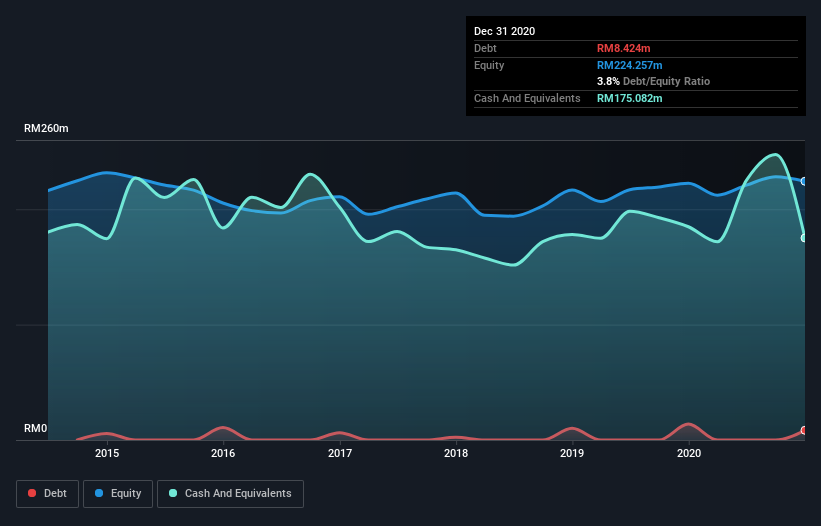- Malaysia
- /
- Specialty Stores
- /
- KLSE:AMWAY
Here's Why Amway (Malaysia) Holdings Berhad (KLSE:AMWAY) Can Manage Its Debt Responsibly

The external fund manager backed by Berkshire Hathaway's Charlie Munger, Li Lu, makes no bones about it when he says 'The biggest investment risk is not the volatility of prices, but whether you will suffer a permanent loss of capital.' When we think about how risky a company is, we always like to look at its use of debt, since debt overload can lead to ruin. We can see that Amway (Malaysia) Holdings Berhad (KLSE:AMWAY) does use debt in its business. But is this debt a concern to shareholders?
What Risk Does Debt Bring?
Generally speaking, debt only becomes a real problem when a company can't easily pay it off, either by raising capital or with its own cash flow. Ultimately, if the company can't fulfill its legal obligations to repay debt, shareholders could walk away with nothing. However, a more usual (but still expensive) situation is where a company must dilute shareholders at a cheap share price simply to get debt under control. Of course, plenty of companies use debt to fund growth, without any negative consequences. The first step when considering a company's debt levels is to consider its cash and debt together.
See our latest analysis for Amway (Malaysia) Holdings Berhad
What Is Amway (Malaysia) Holdings Berhad's Net Debt?
The image below, which you can click on for greater detail, shows that Amway (Malaysia) Holdings Berhad had debt of RM8.42m at the end of December 2020, a reduction from RM13.8m over a year. However, its balance sheet shows it holds RM175.1m in cash, so it actually has RM166.7m net cash.

A Look At Amway (Malaysia) Holdings Berhad's Liabilities
Zooming in on the latest balance sheet data, we can see that Amway (Malaysia) Holdings Berhad had liabilities of RM254.7m due within 12 months and liabilities of RM5.05m due beyond that. On the other hand, it had cash of RM175.1m and RM29.1m worth of receivables due within a year. So its liabilities outweigh the sum of its cash and (near-term) receivables by RM55.6m.
Given Amway (Malaysia) Holdings Berhad has a market capitalization of RM877.8m, it's hard to believe these liabilities pose much threat. However, we do think it is worth keeping an eye on its balance sheet strength, as it may change over time. Despite its noteworthy liabilities, Amway (Malaysia) Holdings Berhad boasts net cash, so it's fair to say it does not have a heavy debt load!
But the bad news is that Amway (Malaysia) Holdings Berhad has seen its EBIT plunge 11% in the last twelve months. If that rate of decline in earnings continues, the company could find itself in a tight spot. The balance sheet is clearly the area to focus on when you are analysing debt. But it is future earnings, more than anything, that will determine Amway (Malaysia) Holdings Berhad's ability to maintain a healthy balance sheet going forward. So if you're focused on the future you can check out this free report showing analyst profit forecasts.
Finally, a business needs free cash flow to pay off debt; accounting profits just don't cut it. Amway (Malaysia) Holdings Berhad may have net cash on the balance sheet, but it is still interesting to look at how well the business converts its earnings before interest and tax (EBIT) to free cash flow, because that will influence both its need for, and its capacity to manage debt. During the last three years, Amway (Malaysia) Holdings Berhad produced sturdy free cash flow equating to 73% of its EBIT, about what we'd expect. This free cash flow puts the company in a good position to pay down debt, when appropriate.
Summing up
We could understand if investors are concerned about Amway (Malaysia) Holdings Berhad's liabilities, but we can be reassured by the fact it has has net cash of RM166.7m. And it impressed us with free cash flow of RM26m, being 73% of its EBIT. So we are not troubled with Amway (Malaysia) Holdings Berhad's debt use. When analysing debt levels, the balance sheet is the obvious place to start. However, not all investment risk resides within the balance sheet - far from it. We've identified 2 warning signs with Amway (Malaysia) Holdings Berhad (at least 1 which is significant) , and understanding them should be part of your investment process.
Of course, if you're the type of investor who prefers buying stocks without the burden of debt, then don't hesitate to discover our exclusive list of net cash growth stocks, today.
If you're looking for stocks to buy, use the lowest-cost* platform that is rated #1 Overall by Barron’s, Interactive Brokers. Trade stocks, options, futures, forex, bonds and funds on 135 markets, all from a single integrated account. Promoted
New: Manage All Your Stock Portfolios in One Place
We've created the ultimate portfolio companion for stock investors, and it's free.
• Connect an unlimited number of Portfolios and see your total in one currency
• Be alerted to new Warning Signs or Risks via email or mobile
• Track the Fair Value of your stocks
This article by Simply Wall St is general in nature. It does not constitute a recommendation to buy or sell any stock, and does not take account of your objectives, or your financial situation. We aim to bring you long-term focused analysis driven by fundamental data. Note that our analysis may not factor in the latest price-sensitive company announcements or qualitative material. Simply Wall St has no position in any stocks mentioned.
*Interactive Brokers Rated Lowest Cost Broker by StockBrokers.com Annual Online Review 2020
Have feedback on this article? Concerned about the content? Get in touch with us directly. Alternatively, email editorial-team (at) simplywallst.com.
About KLSE:AMWAY
Amway (Malaysia) Holdings Berhad
An investment holding company, distributes consumer products in Malaysia.
Flawless balance sheet and good value.
Similar Companies
Market Insights
Community Narratives



